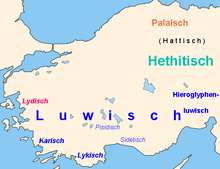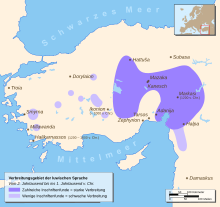Luwian language
| Luwian | |
|---|---|
 Luwian hieroglyph BOS (cow) | |
| Native to | Hittite Empire, Arzawa, Neo-Hittite kingdoms |
| Region | Anatolia, Northern Syria |
| Extinct | around 600 BC |
Indo-European
| |
| Language codes | |
| ISO 639-3 | Either:xlu – Cuneiform Luwianhlu – Hieroglyphic Luwian |
xlu Cuneiform Luwian | |
hlu Hieroglyphic Luwian | |
| Glottolog | luvi1235 |
 Distribution of the Luwian language (in German) | |

Luwian (/ˈluːwiən/), sometimes known as Luvian or Luish, is an ancient language, or group of languages, within the Anatolian branch of the Indo-European language family. The ethnonym Luwian comes from Luwiya (also spelled Luwia or Luvia) – the name of the region in which the Luwians lived. Luwiya is attested, for example, in the Hittite laws.[1]
The two varieties of Proto-Luwian or Luwian (in the narrow sense of these names) are known after the scripts in which they were written: Cuneiform Luwian (CLuwian) and Hieroglyphic Luwian (HLuwian). There is no consensus as to whether these were a single language or two closely related languages.
Classification[]
Several other Anatolian languages – particularly Carian, Lycian, Lydian and Milyan (also known as Lycian B or Lycian II) – are now usually identified as related to Luwian – and as mutually connected more closely than other constituents of the Anatolian branch.[2] This suggests that these languages formed a sub-branch within Anatolian. Some linguists follow Craig Melchert in referring to this broader group as Luwic,[3] whereas others refer to the "Luwian group" (and, in that sense, "Luwian" may mean several distinct languages). Likewise, Proto-Luwian may mean the common ancestor of the whole group, or just the ancestor of Luwian (normally, under tree-naming conventions, were the branch to be called Luwic, its ancestor should be known as Proto-Luwic or Common Luwic; in practice, such names are seldom used). Luwic or Luwian (in the broad sense of the term), is one of three major sub-branches of Anatolian, alongside Hittite and Palaic.[2]
As Luwian has numerous archaisms, it is regarded as important to the study of Indo-European languages (IE) in general, the other Anatolian languages, and the Bronze Age Aegean. These archaisms are often regarded as supporting the view that the Proto-Indo-European language (PIE) had three distinct sets of velar consonants:[4] plain velars, palatovelars, and labiovelars. For Melchert, PIE *ḱ → Luwian z (probably [ts]); *k → k; and *kʷ → ku (probably [kʷ]). Luwian has also been enlisted for its verb kalut(t)i(ya)-, which means "make the rounds of" and is probably derived from *kalutta/i- "circle".[5] It has been argued[6] that this derives from a proto-Anatolian word for "wheel", which in turn would have derived from the common word for "wheel" found in all other Indo-European families. The wheel was invented in the 5th millennium BC and, if kaluti does derive from it, then the Anatolian branch left PIE after its invention (so validating the Kurgan hypothesis as applicable to Anatolian). However, kaluti need not imply a wheel and so need not have been derived from a PIE word with that meaning. The IE words for a wheel may well have arisen in those other IE languages after the Anatolian split.
Geographic and chronological distribution[]
Luwian was among the languages spoken during the 2nd and 1st millennia BC by groups in central and western Anatolia and northern Syria.[7] The earliest Luwian texts in cuneiform transmission are attested in connection with the Kingdom of Kizzuwatna in southeastern Anatolia, as well as a number of locations in central Anatolia. Beginning in the 14th century BC, Luwian-speakers came to constitute the majority in the Hittite capital Hattusa.[8] It appears that by the time of the collapse of the Hittite Empire ca. 1180 BC, the Hittite king and royal family were fully bilingual in Luwian. Long after the extinction of the Hittite language, Luwian continued to be spoken in the Neo-Hittite states of Syria, such as Milid and Carchemish, as well as in the central Anatolian kingdom of Tabal that flourished in the 8th century BC.[9]
A number of scholars in the past attempted to argue for the Luwian homeland in western Anatolia. According to James Mellaart, the earliest Indo-Europeans in northwest Anatolia were the horse-riders who came to this region from the north and founded Demircihöyük (Eskisehir Province) in Phrygia c. 3000 BC. They were allegedly ancestors of the Luwians who inhabited Troy II, and spread widely in the Anatolian peninsula.[10] He cited the distribution of a new type of wheel-made pottery, Red Slip Wares, as some of the best evidence for his theory. According to Mellaart, the proto-Luwian migrations to Anatolia came in several distinct waves over many centuries. The recent detailed review of Mellaart's claims suggests that his ethnolinguistic conclusions cannot be substantiated on archaeological grounds.[11]
Other arguments were advanced for the extensive Luwian presence in western Anatolia in the late second millennium BC. In the Old Hittite version of the Hittite Code, some, if not all, of the Luwian-speaking areas were called Luwiya. Widmer (2007) has argued that the Mycenaean term ru-wa-ni-jo, attested in Linear B, refers to the same area.[12] but the stem *Luwan- was recently shown to be non-existent.[13] In a corrupt late copy of the Hittite Code the geographical term Luwiya is replaced with Arzawa[14] a western Anatolian kingdom corresponding roughly with Mira and the Seha River Land.[15] Therefore, several scholars shared the view that Luwian was spoken—to varying degrees—across a large portion of western Anatolia, including Troy (Wilusa), the Seha River Land (Sēḫa ~ Sēḫariya, i.e., the Greek Hermos river and Kaikos valley), and the kingdom with its core being the Maeander valley.[16] In a number of recent publications, however, the geographic identity between Luwiya and Arzawa was rejected or doubted.[17] In the post-Hittite era, the region of Arzawa came to be known as Lydia (Assyrian Luddu, Greek Λυδία), where the Lydian language was in use. The name Lydia has been derived from the name Luwiya (Lydian *lūda- < *luw(i)da- < luwiya-, with regular Lydian sound change y > d).[18] The Lydian language, however, cannot be regarded as the direct descendant of Luwian and probably does not even belong to the Luwic group (see Anatolian languages). Therefore, none of the arguments in favour of the Luwian linguistic dominance in Western Asia Minor can be regarded as compelling, although the issue continues to be debated.
Script and dialects[]

Luwian was split into many dialects, which were written in two different writing systems. One of these was the Cuneiform Luwian which used the form of Old Babylonian cuneiform that had been adapted for the Hittite language. The other was Hieroglyphic Luwian, which was written in a unique native hieroglyphic script. The differences between the dialects are minor, but they affect vocabulary, style, and grammar. The different orthographies of the two writing systems may also hide some differences.
Cuneiform Luwian[]
Cuneiform Luwian is the corpus of Luwian texts attested in the tablet archives of Hattusa; it is essentially the same cuneiform writing system used in Hittite.[19] In Laroche's Catalog of Hittite Texts, the corpus of Hittite cuneiform texts with Luwian insertions runs from CTH 757–773, mostly comprising rituals.[20] Cuneiform Luwian texts are written in several dialects, of which the most easily identifiable are Kizzuwatna Luwian, Luwian, and Empire Luwian.[21] The last dialect represents the vernacular of Hattusan scribes of the 14th–13th centuries BC and is mainly attested through Glossenkeil words in Hittite texts.
Compared to cuneiform Hittite, logograms (signs with a set symbolic value) are rare. Instead, most writing is done with the syllabic characters, where a single symbol stands for a vowel, or a consonant-vowel pair (either VC or CV). A striking feature is the consistent use of 'full-writing' to indicate long vowels, even at the beginning of words. In this system a long vowel is indicated by writing it twice. For example, īdi "he goes" is written i-i-ti rather than i-ti, and ānda "in" is written a-an-ta rather than an-ta.
Hieroglyphic Luwian[]

Hieroglyphic Luwian is the corpus of Luwian texts written in a native script, known as Anatolian hieroglyphs.[23][24] Once thought to be a variety of the Hittite language, "Hieroglyphic Hittite" was formerly used to refer to the language of the same inscriptions, but this term is now obsolete. The dialect of Luwian hieroglyphic inscriptions appears to be either Empire Luwian or its descendant, Iron Age Luwian.
The first report of a monumental inscription dates to 1850, when an inhabitant of Nevşehir reported the relief at . In 1870, antiquarian travellers in Aleppo found another inscription built into the south wall of the Al-Qaiqan Mosque. In 1884, Polish scholar discovered an inscription near , in western Turkey. The largest known inscription was excavated in 1970 in Yalburt, northwest of Konya. Luwian hieroglyphic texts contain a limited number of lexical borrowings from Hittite, Akkadian, and Northwest Semitic; the lexical borrowings from Greek are limited to proper nouns, although common nouns borrowed in the opposite direction do exist.[25]
Phonology[]
The reconstruction of the Luwian phoneme inventory is based mainly on the written texts and comparisons with the known development of other Indo-European languages. Two series of stops can be identified, transliterated as geminate in the cuneiform script. These fortis and lenis stops may have been distinguished by either voicing or gemination. The contrast was lost initially and finally, suggesting that any voicing only appeared intervocalically.[26]
The following table provides a minimal consonant inventory, as can be reconstructed from the script. The existence of other consonants, which were not differentiated in writing, is possible.
| Bilabial | Alveolar | Palatal | Velar | Uvular | ||
|---|---|---|---|---|---|---|
| Nasal | fortis | *m: ⟨mm⟩ | *n: ⟨nn⟩ | |||
| lenis | *m ⟨m⟩ | *n ⟨n⟩ | ||||
| Plosive | fortis | *p ⟨pp⟩ | *t ⟨tt⟩ | *k ⟨kk⟩ | ||
| lenis | *b ⟨p⟩ | *d ⟨t⟩ | *ɡ ⟨k⟩ | |||
| Fricative | fortis | *s ⟨šš⟩ | *x~χ ⟨ḫḫ⟩ | |||
| lenis | *z ⟨š⟩ | *ɣ~ʁ ⟨ḫ⟩ | ||||
| Affricate | fortis | *t͡s ⟨zz⟩ | ||||
| lenis | *d͡z ⟨z⟩ | |||||
| Trill | *r | |||||
| Approximant | *w | *l | *j | |||
There are only three vowels, a, i, and u, which could be short or long. Vowel length is not stable but changes with the stress and word position. For example, annan occurs alone as an adverb as ānnan ('underneath') but as a preposition, it becomes annān pātanza ('under the feet').